Cheek Volume Loss
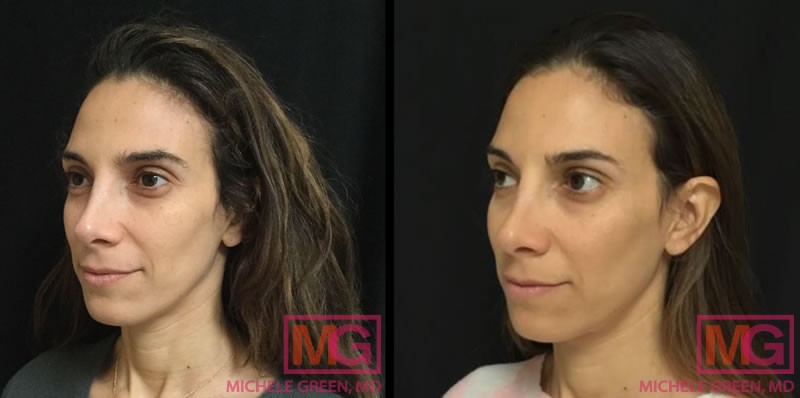
As we age, the production of the structural proteins collagen and elastin begins to decrease, resulting in sagging skin, fine lines, wrinkles, and volume loss. In youth, the face is characterized by a general v-shape appearance with firm skin, full cheeks, and a well-defined jawline. However, due to the natural aging process, the fat pads in the cheeks drop, and skin laxity increases, forming jowls along the jawline and hollows in the midface. While the passage of time is the most significant factor for developing volume loss in the midface and lower face, lifestyle factors, including prolonged sun exposure, an unhealthy diet, genetics, and smoking, can enhance the effects of the natural aging process. Many patients falsely believe that the only way to address these signs of aging and access a more contoured, youthful look is to visit a plastic surgeon for a surgical procedure, such as a facelift. Still, many non-surgical treatment options are available to boost collagen production, improve skin elasticity, and fill in lost face volume. The first step to achieving a naturally youthful appearance is to schedule a consultation with board-certified dermatologist Dr. Michele Green.
When treating loss of facial volume, Dr. Green will often turn to injectable dermal fillers. Dermal fillers serve many functions in anti-aging treatment. They can reduce creases and wrinkles, such as the nasolabial folds around the nose and mouth, marionette lines extending down the chin, and tear trough lines from the eyes. Some types of filler can be used for jawline enhancement and chin augmentation to help improve facial contour. To address a loss of skin volume, Dr. Green employs hyaluronic acid fillers Restylane Lyft and Juvederm Voluma or the poly-L-lactic acid-based filler Sculptra. Collagen production increases by injecting these dermal fillers into the midface, restoring lost volume and giving patients a naturally more youthful appearance. Dermal fillers are long-lasting treatment options without the need for any downtime, with results that last for up to a year. With several dermal filler options, seeking treatment from an expert injector, such as Dr. Green, is essential.
Experienced, board-certified dermatologist Dr. Michele Green has been masterfully treating patients in her Upper East Side New York City dermatology office for more than 25 years. Dr. Green is an expert in many anti-aging treatments, including dermal fillers, Botox, radiofrequency energy treatment, Microneedling, chemical peels, and more, providing complete facial rejuvenation. Highly adept at meeting each patient where they are, Dr. Green listens to each patient’s unique aesthetic goals and needs to generate the treatment plan that will be best for them. With her proprietary line of skincare products, MGSKINLABs, Dr. Green can also make recommendations for lotions, creams, and serums that can be used on all areas of the face to combat the natural aging process every day. Well-known for high patient satisfaction, Dr. Green has been frequently voted one of the best healthcare providers in New York City by such publications as Castle Connolly, Super Doctors, and New York Magazine.
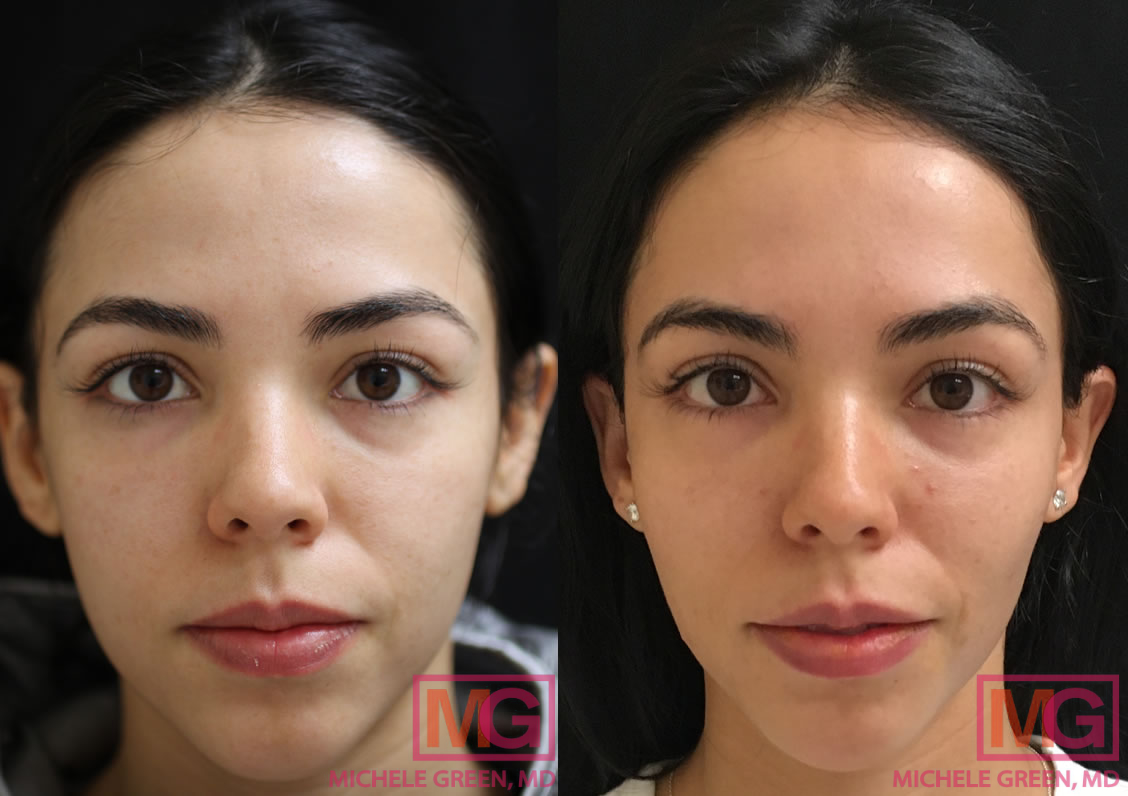
What causes facial volume loss?
Facial volume loss can be one of the first and most noticeable signs of the natural aging process as the production of the body’s natural structural proteins decreases. In youth, high production of collagen and elastin keeps the skin looking smooth and firm, and fat pads on the cheekbones contribute to a healthy plumpness of the cheeks. Starting in our late 20s and early 30s, the production of collagen and elastin slows, leading to loose skin and the appearance of fine lines and wrinkles, and the fat pads in the cheeks begin to drop, resulting in volume loss in the midface and, contributing to the formation of jowls. Facial volume loss can also contribute to the appearance of hollows under the eyes and sunken cheekbones, making you look older than you are. While volume loss is generally a gradual process, treatment can begin as soon as you notice the signs of aging, and the best first step is to consult with board-certified dermatologist Dr. Green.
Can injectable dermal fillers be used to treat volume loss?
When patients ask if dermal fillers can be used to treat volume loss, the answer is they can! Different types of dermal fillers differ in composition but serve a similar function and can be used to restore lost volume, fill in wrinkles, and enhance areas of the face, such as the chin, jawline, and lips. Hyaluronic acid fillers, such as the Restylane and Juvederm family of fillers, are some of the most commonly used fillers in the United States. With the active ingredient hyaluronic acid (HA), a polysaccharide that attracts and binds moisture, HA fillers can be used in many areas of the face to restore a plump, hydrated, smooth look to the skin. When treating volume loss, Dr. Green will turn to Restylane Lyft or Juvederm Voluma, two hyaluronic acid fillers explicitly designed for use in the midface. With a thicker gel composition, Restylane Lyft and Juvederm Voluma can enhance the cheekbones, eliminate hollows under the eyes, and restore lost facial volume.
Another dermal filler used on the midface is the poly-L-lactic acid-based filler Sculptra. Produced by the company Galderma, Sculptra is a collagen stimulator, meaning that after injection, it continues to act over time to boost collagen production in the treatment area for naturally youthful-looking results. As a result, the effects of the treatment will become visible after 4-6 weeks but continue to improve for up to 4-6 months after each Sculptra injection, with results that can last up to 2 years. Restylane Lyft, Juvederm Voluma, and Sculptra injections are all available at Dr. Green’s New York City dermatology office. No one treatment is necessarily “better” than the other. Instead, Dr. Green will examine the treatment area and choose the treatment option that will be best for your specific needs.
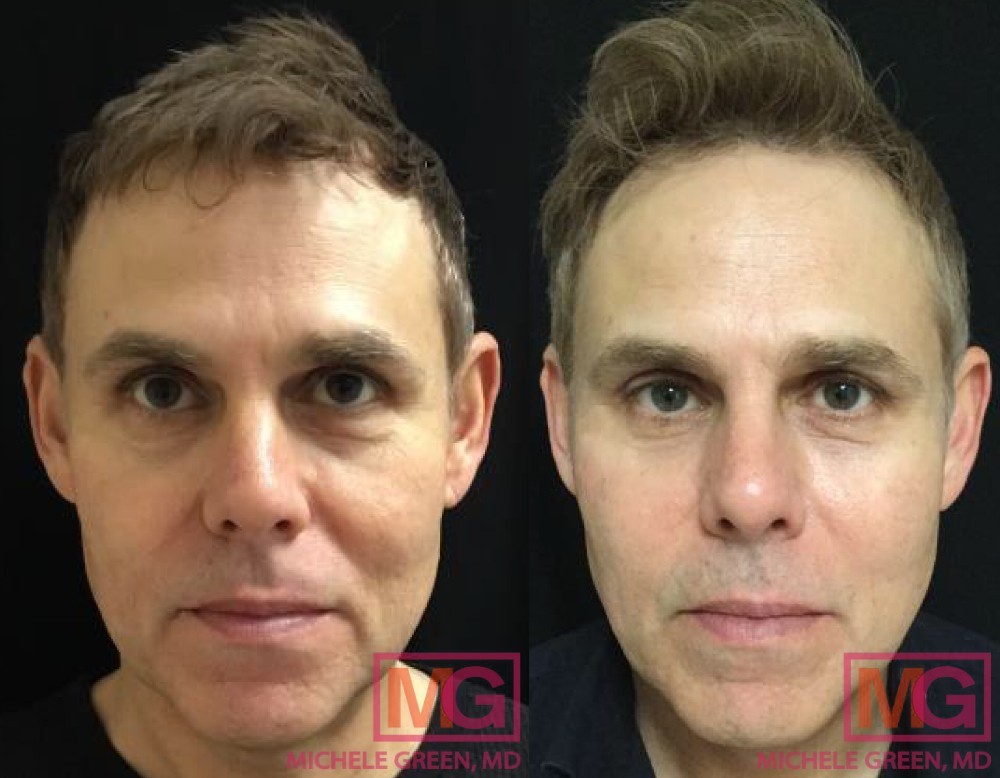
How to treat volume loss in the cheeks with Juvederm Injectable
The Juvederm family of dermal fillers produced by Allergan Aesthetics (an AbbVie company) is the most popular type of dermal filler available. There are six members of the Juvederm family, including Juvederm Ultra XC, Juvederm Ultra Plus XC, Juvederm Volbella XC, Juvederm Vollure XC, Juvederm Volux XC, and Juvederm Voluma XC, which are all used on different areas of the face for various functions. Juvederm Voluma is the product to use when treating facial volume loss. Formulated with a thicker gel than most members of the Juvederm portfolio, Juvederm Voluma is designed specifically for use in the midface to restore lost volume. When Juvederm Voluma is injected deep into the cheek area, the filler acts as structural support to the skin, enhancing the contour of the cheekbones, filling in lost volume, and reducing the appearance of hollows in the face. Formulated with hyaluronic acid and a proprietary cross-linking technology for structure under the skin, Juvederm Voluma can last for up to two years, providing a long-lasting, youthful look.
How to treat loss of cheek volume with Restylane dermal fillers
Restylane is another family of hyaluronic acid fillers that are very safe and effective for anti-aging treatment. Produced by the company Galderma, the Restylane family of dermal fillers is comprised of Restylane Silk designed for filling in fine lines around the mouth, Restylane Defyne for deep wrinkles around the nose and mouth, Restylane Refyne for mild to moderate wrinkles around the nose and mouth, Restylane Kysse for lip enhancement, and Restylane Lyft to restore lost volume in the midface. Using their proprietary XpresHAn technology, Restylane Lyft provides structure and support to the cheeks while being flexible enough to support a full range of facial expressions. When injected into the cheeks and midface, Restylane Lyft creates a lifted, youthful appearance to the face while reducing the appearance of wrinkles, hollows, and jowls. With optimal injections, the results of Restylane Lyft can last in the cheeks for up to a year. Many patients schedule yearly touch-up appointments with Dr. Green to maintain the treatment results.
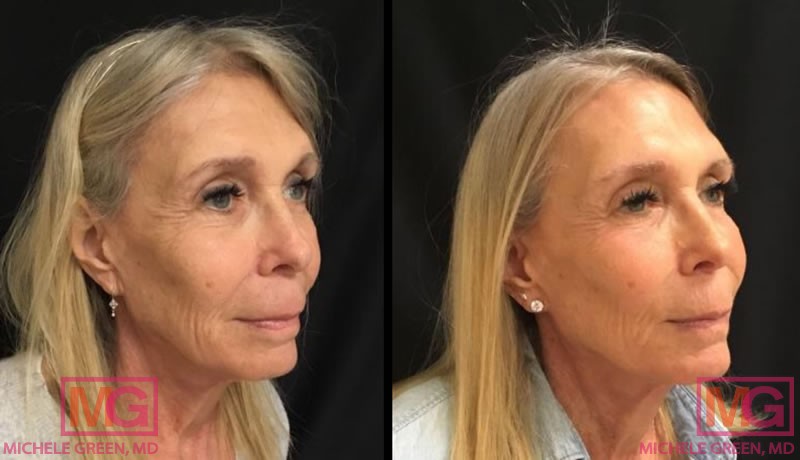
What causes Facial Volume Loss?
While the natural aging process is the primary driver of volume loss in the face, several environmental factors can increase the appearance of volume loss, sagging skin, wrinkles, and hollows, including sudden weight loss, sun damage, smoking, and unhealthy eating habits.
Sudden weight loss can cause volume loss to occur in the midface. If weight loss happens quickly, the fat pads and tissue under the skin shrink while the skin remains stretched and loose. This can lead to a sagging, gaunt appearance on the cheeks.
Sun damage, caused by unprotected sun exposure, can wreak havoc on the skin’s surface, leading to thinner skin, age spots, and decreased elasticity. Thin skin is more susceptible to volume loss over time, and loose skin can make volume loss more apparent.
Smoking can lead to many health concerns in the body, including exacerbating signs of the natural aging process. Smoking can lead to thinner, wrinkled skin, making volume loss more visible.
What causes volume loss in the cheeks?
In youth, we experience a healthy plumpness in the cheeks that provides a lifted, contoured appearance to the face. The skin is tight and has high elasticity, meaning that it will stretch and then return to its shape, and the general outline of the face forms a V-shape where the high cheekbones slope into a defined chin. As we age, the production of the structural proteins decreases, and the skin becomes looser, taking on a droopy, crepey appearance. The fat pads that create fullness in the cheeks drop, making the lower face appear heavier, forming jowls. A decrease in structural proteins leads to a loss of facial volume in the midface, contributing to a sunken, hollow look under the eyes and in the cheeks. Dermal filler injections are the best way to restore lost volume and regain a naturally youthful look.
What causes sunken cheeks?
The natural aging process can bring many changes to the face and body, with one visible change being sunken cheeks in the midface. Sunken cheeks occur due to volume loss caused by decreased collagen and elastin production. As we age, collagen and elastin production naturally decrease. Still, a genetic predisposition or environmental factors, such as smoking, sun damage, an unhealthy diet, or sudden weight loss, can exacerbate sunken cheeks.
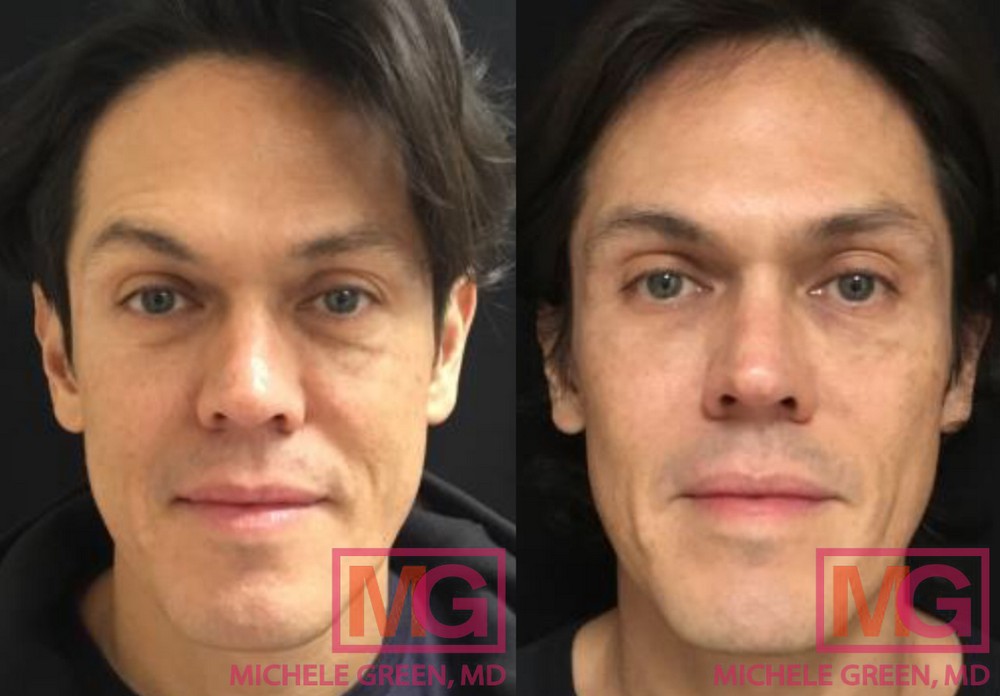
How to restore cheek volume
The first step in the cheek volume restoration procedure is to schedule a consultation appointment with expert, board-certified dermatologist Dr. Michele Green. Dr. Green will begin the consultation by asking you to share your aesthetic goals and any medical history so she can determine the treatment plan that will best meet your needs. For many patients experiencing volume loss on the midface, dermal fillers such as Restylane Lyft, Juvederm Voluma, or Sculptra injections will be the treatment option most suited to restore a naturally youthful appearance.
In the days before the dermal filler treatment session, Dr. Green will ask you to refrain from taking blood thinners, such as Advil or fish oil, to reduce the risk of bruising post-treatment. When you arrive in Dr. Green’s office for your appointment, she will begin by applying a topical numbing cream to the treatment area to reduce the risk of discomfort during treatment. Dr. Green will then mark the injection sites on the treatment area and begin injections with an ultra-fine needle. In addition to the topical numbing cream, most dermal fillers are formulated with a numbing agent to reduce the risk of discomfort during the procedure. The injections themselves are relatively quick, requiring only 20-30 minutes, depending on the size and scope of the treatment area. Following the process, patients can immediately return to their regularly scheduled activities without downtime. Any side effects patients experience are generally mild, including swelling, redness, bruising, and pain at the injection site, and will typically resolve independently within 5-7 days.
Why do we lose cheek volume?
A loss of facial volume is natural and most often due to age-related factors, such as decreased collagen and elastin production starting in your late 20s. But just because volume loss is natural does not mean we have to live with it. Several cosmetic procedures can reduce the appearance of volume loss in the cheeks and midface, including dermal fillers to restore lost volume and radiofrequency energy lasers to tighten the skin.
How to restore volume to your cheeks naturally
Volume loss in the cheeks occurs naturally over time due to decreased collagen and elastin production and atrophy of fat tissue in the midface. While these signs of aging cannot be wholly reversed without a cosmetic procedure, such as dermal filler injections, some lifestyle changes can slow volume loss on the face. One of the most crucial skincare steps to prevent all signs of aging, including volume loss, the development of wrinkles, thinning skin, and discoloration, is to apply sunscreen of SPF 30 or higher every day. Sun damage can cause significant problems on the skin, so the best way to slow the natural aging process is always to apply sunscreen. Additionally, patients can maintain collagen production by eating foods rich in vitamin C and taking collagen supplements. Supporting collagen production helps provide skin structure, slowing volume loss. Foods rich in antioxidants, such as nuts, leafy greens, vegetables, and fruit, can help slow natural aging by protecting the skin from free radicals. Patients can also slow the aging process by quitting smoking. While natural solutions such as sun protection, eating well, and avoiding smoking can help to slow the natural aging process, cosmetic procedures such as dermal fillers will ultimately be more effective at restoring lost volume and providing a more youthful appearance.
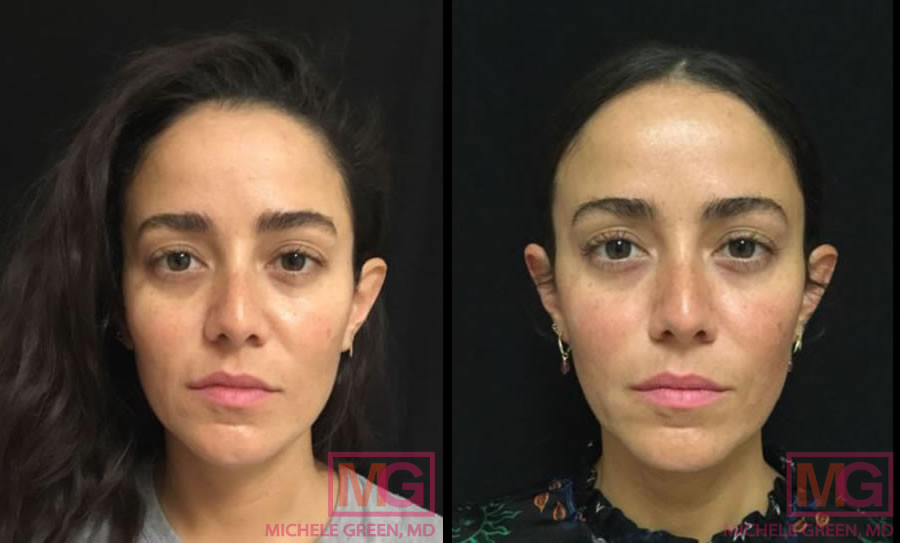
How to get the volume back in the cheeks today
Volume loss occurs in the cheeks due to the natural aging process when the production of the structural proteins collagen and elastin decreases, and the fat pads begin to drop. Age-related volume loss generally starts in your late 20s and early 30s, continuing over time and creating a sunken, gaunt, hollow look under the eyes and in the midface. Luckily, a non-surgical solution for facial volume loss is available at board-certified dermatologist Dr. Michele Green’s Upper East Side New York City office: dermal fillers. Several dermal fillers can restore lost volume in the cheeks and midface, including hyaluronic acid fillers Juvederm Voluma and Restylane Lyft and the poly-L-lactic acid-based filler Sculptra. With the injection of dermal fillers into the midface, patients can expect to see defined, fuller cheekbones that reduce the appearance of hollows under the eyes and provide the face with a more contoured look.
Dr. Michele Green is an internationally renowned board-certified dermatologist with over two and a half decades of experience providing some of the world’s most discerning individuals with the best non-invasive cosmetic procedures, including dermal fillers for cheek enhancement. Regarding facial rejuvenation, Dr. Green takes a holistic approach and embraces a less-is-more philosophy, customizing each patient’s treatment plan to cater best to their particular skin concerns and ideal aesthetic goals. She is consistently identified as one of New York City’s best dermatologists by New York Magazine, Castle Connolly, and Super Doctors for her dedication to her patients and expertise. To schedule a consultation with Dr. Green and develop a personalized plan for achieving a natural-looking, more youthful appearance, call us today at 212-535-3088 or contact us online.
 212-535-3088
212-535-3088